Listening to a ZOE podcast on dark chocolate I was intrigued by the phrase “bliss point.”
Arguably it was the first bliss point food. So by bliss point, you know, you guys will know this because your food experts, but the idea that, you know, if you combine sugar, salt, and fat, we all suddenly become unable to resist it.
Spencer Hyman
So this set me off of on a research project connecting I had just heard, with what I already knew about ultra processed foods (UPFs) – only for Michael Pollan’s Netflix* series “Cooked” (that I had only just started watching to learn more about making bread in episode 3 “Air”) covered the very issue of why food companies are interested in combining sugar, salt, and fat and the rise and rise of ultra processed food (UPFs) – episode 2 “Water” at around 27 minutes– released 2016.
Michael Pollan is an acclaimed author and natural food advocate. Pollan has been writing about various aspects of food consumption and production for decades author and natural food advocate.
What is the bliss point?
It is the point at which the combination of salt, sugar, or fat, is “rewarded” by the brain with a spurge of endorphins. There are frequent references to the work of scientist Harold Moskowitz in the 1950s. In his research, he discovered that humans both have a natural sense of satiety and know when they’ve eaten enough. We become bored with the same tastes, flavours and textures. Moskowitz also discovered that if you combine sugar, salt, and fat with interesting flavourings and textures, we experience or hit a “bliss point”. Pringles have a valid catch phrase.
We are ‘programmed’ to seek out and enjoy products that contain sugar, salt or fat and are rewarded for it with a dopamine hit. These three ingredients act synergistically to make us want to eat more. Essentially, they override our ability to feel satiated and stop eating.
Until recently, few foods combined this “insatiable” trio – other than mother’s milk. However, starting with Moskowitz, food scientists experimented with, and eventually optimised, different doses of sugar, salt and fat. They figure out how to override the brain’s natural ‘stop’ signals across many products – what is referred to as “food product optimisation” – in ultra processed foods. Remember the ice-creams reflection?
Applications of the bliss point are coming under greater scrutiny. Encouraging addiction-like behaviours around eating. Dr Van Tulleken does not hold back.
This bliss point plays a significant role in why we crave certain addictive foods, such as ice cream and crisps. Even in the most strong-willed individuals, these cravings can seem impossible to resist.
Of course, food brings pleasure in many other ways; for example, by producing feelings of nostalgia or enjoying food socially with family and friends.
There are also strong messages being shared in the research around the consumption of ultra processed foods and maternal-child health. I will pause there a moment.
Which foods are engineered to reach the ‘bliss point’?
Surprisingly, it’s not just the foods that you’d expect which have been engineered in this way. I am confident you would target cakes, biscuits, ice-cream, crisps and chocolate.
What about ketchup? Soup? Cereal? Supermarket “foam” bread – check the ingredients (sugar and salt are hidden inside).
These products can contain that longed-for trio of salt, sugar, and fat that keeps us coming back for more and promotes future cravings. Add to that trio, additives to promote even great “hyperpalatability” and “mouthfeel”.
Why do these foods lead to us overeating?
So what’s going on when we consume foods engineered like this? Why can’t we get enough?
By triggering reward pathways in our brain – dopamine signalling. Dopamine is a neurotransmitter (chemical messenger) in the brain that is involved with feelings of “bliss,” also motivation and pleasure. The ‘context-dependent’ memory of eating chocolate makes me feel good encourages our brain to suggest ‘eating chocolate might help.’ Repeat – and the bliss too easily becomes a habit. This leads to a perpetual cycle of cravings, eating more foam bread, more cravings…
What did the mice do?
A study demonstrated that when rats eat sugars and fats separately, their brains send them messages to stop when they’re full. However, when combined in a deliciously decadent duo, their pleasure receptors went into overdrive, overpowering that internal stop switch. The more of the bliss-point foods the rats consumed, the more they had to eat to get that same pleasure hit next time. This suggests that the more we consume bliss point foods, the more likely we are to overeat.
Remember – childhood obesity has increased tenfold globally over the past 50 years, while 21% of UK children are obese by the time they leave primary school.
So what?
Are we back to the bottom line discussed here? Whole-food-plant-based?
Whole-food, plant-based. Habits, wellness and nutrition – especially educating yourself about and read the label. And finally, the when, what, and how and who with – you eat your food. There are other bliss points.
I was wondering – can I use this knowledge and know of the food matrix to my advantage? I was thinking about the dessert that is cooking in the oven, pear and blackberry healthy crumble. Some of the oat cake recipes add a little salt to “enhance” flavours? Is it possible to engineer healthier food combos of sugar, salt and fat?
The final word is from an Atlantic post “More Than Half of What Americans Eat Is ‘Ultra-Processed,” that references Pollan.
…ultra-processed sugar bombs are replacing ‘more nutrient-dense foods,’ and leaving people “simultaneously overfed and undernourished.”
Julie Beck (2016)





Pingback: Nutrition, well-being and habits at 82 days – Edventures
Pingback: Nice-cream – really is! – Edventures